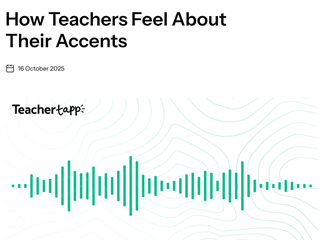I found myself embroiled in quite a heated discussion on social media recently about the teaching of writing, both to younger students and older ones, including those who are lower attaining. It was about whether children can be taught to write better through oracy, by being encouraged to speak in sentences, saying things out loud in a ‘writing’ style that then can be translated into writing itself. Now I do believe that talk is incredibly important for the development of writing, particularly exploratory, ‘messy’ talk that helps students ‘stretch’ their language and ‘float their notions’ in an atmosphere that is relaxed enough to allow that (A Language for Life, Bullock, 1975). But the argument here was focused on a very specific use of talk, the kind of talk no-one really does naturally, involving talking as if you’re writing. I have strong reservations about this ‘practising’ via a spoken-style that is entirely false.
At the same time, I saw an example of AI-assisted marking and how it might be used to offer feedback to students on their writing. Much of the attention for feedback was on improving the ‘form’ of the writing – the ways that quotations were embedded and the ways in which evidence was used in sentences, rather than on the content, the substance of the answer. Though there may be scope for more content-based comment, it’s clear that AI could contribute to the narrowing of what seems to be acceptable in terms of writing to the precise algorithms of examination answers.
A third recent experience was reading a set of arguments on social media suggesting that, especially in early years and primary, children are being expected to write in extended forms too quickly, and that it’s important that they should ‘master’ basic, simple structures such as sentences before being ‘expected’ to write in longer, more expansive forms. (I believe this is something that Ofsted noted in its inspection documents).
Finally, over a period of time, I’ve also been noticing high-profile educationalists blogging or sharing extensive work on ‘the sentence’, on teaching named ‘sentence-types’, to be practised and repeated until students feel confident to use them in their own writing. It has to be said that none of these multiple named ‘types’ are ones I’ve ever heard of before. The ‘Not, Nor, Nor’ sentence, the ‘Or and Or’ sentence, the ‘Comma Sandwich’ and the ‘Three Verb’ sentence are not familiar to me as ways of thinking about how to put my ideas into my writing, nor have they been part of common practice in the teaching of writing till very recently. This is something new.
All of these things come together for me as troubling developments in the teaching of writing. They emphasise practising forms, mainly sentence structures, in order to learn how to do them and then incorporate them in writing.
That’s not to say that work on the detail of writing and thinking about sentences is unimportant. It is important. Sentences are important. It’s just that teaching writing at the level of the sentence, focusing on form divorced from meaning, and critically from writers’ own intentions, seems like a dangerous blind alley. And teaching sentences divorced from other aspects of language (whole discourse structures, genres of writing, vocabulary choices and use of narrative voice and perspective) is also potentially unhelpful. As Myra Barrs showed brilliantly in her article ‘Teaching Bad Writing’, an emphasis on form and style detached from substance, and from other aspects of language, can not only lead to poor development of ideas but also bad writing.
Alongside all of this, I have been involved in thinking about something very important to me, the idea of ‘creative-criticality’, collaborating with colleagues in HE and ITT on a bid for a funded project to develop this practice across phases. Here, there is a recognition of the intimate relationship between reading and writing, with an understanding that writing grows out of familiarity with texts and what writers before you have done. Writing can’t be taught by practising writing. It has to be deeply connected to reading, and talking about reading.
The five-year-old early writer, who writes ‘Once upon a time…’ or ‘And so, it all ended happily’, or ‘Chapter 2’ at the start of three lines of writing, or ‘Here’s the moment you’ve all been waiting for…’ is not being trained to use sentence types. They are, instead, drawing on all the conventions of the stories they have heard, either told to them or read to them. They have heard writers and are beginning to discover that they too can be one, by adopting the features of the genres they have encountered. And there is a continuity between this kind of imitation, trying on the style, absorbing conventions at the earliest age, and the kind of writing that happens later on, in student stories or essays.
It’s my view that even with that most tricky of forms, the GCSE or A Level essay, students begin to grasp their style, conventions and language by reading examples of writing in that style – each others’ essays, teachers’ modelling of examples, articles and reviews, features and editorials, history books, science blogs and so on. They can see how writers use sentences and other aspects of language in situ, in order to express their own intentions in particular contexts and for particular audiences. They can discover the multiplicity of approaches and choices that these writers make – no one writing formula but multiple possibilities. Teaching them sentence types, getting them to practise these and ‘demonstrate’ them into their writing is foregrounding the wrong things. The question should be ‘What do you want to say? Now how can you express this best, bearing in mind how you’ve seen other writers do it?’ with lots of focus on the ideas themselves – how interesting, entertaining, robust, well-judged and insightful they are, depending on the kind of writing.
One other point to make about this. We used to talk about ‘voice’ and how to develop it. It’s still talked about in literary criticism exploring what’s special about poetry. But somewhere in the approach to student writing described above, voice has gone missing. It doesn’t seem to matter that all students might say the same kind of thing in exactly the same way, rather than developing a unique and special voice of their own. So, if everyone starts with the named sentence that’s been taught to them, that’s regarded as a teaching success, rather than looking for something personal, authentic and committed that expresses the personality and individual thought of a particular person.
I hope when you read my writing, you recognise me in it. I hope that the style, choice of words and sentence structures are ones that leave my authorial fingerprint. I hope you like how I write and come away thinking you’ve got to know me a bit through my writing. And that’s not just in a blog like this. If I write an article in emagazine about poetry, or The Great Gatsby, I want my fingerprint to be on that as well. For students, developing their own voice seems important too. It’s part of discovering what kind of writer you want to be, how you can express your ideas in a unique way, and make writing serve your purposes, your important and serious intentions. If I am told that I must put in a ‘Not, Nor, Nor’ sentence, it stops me from focusing on my own intentions and making the kinds of decisions about how to express myself that will ultimately make me a better writer.
Starting with writers’ ‘intentions’ is important. This extract from the section on writing in A Language for Life expresses this idea brilliantly.
a recognition on the part of teachers that a writer's intention is prior to his need for techniques. The teacher who aims to extend the pupil's power as a writer must therefore work first upon his intentions, and then upon the techniques appropriate to them. When this is understood there is every reason why spontaneity should be an element in a great deal of what a child writes. Spontaneity then becomes capable of surviving the transition from artlessness to art; or in plainer terms, of supporting a writer in his search for new techniques appropriate to his novel intentions.
Finally, here's a bit of exemplification for you, to show you what I mean. You’re teaching students about a poem in anything from Year 5 to Year 9. The poem is ‘Snake’ by D.H. Lawrence. You focus on a short section. You want the class to be attentive to the sound effects and perhaps introduce the idea of alliteration, maybe using the word itself, and you want to develop both their ability to talk about the poem and then to write about it.
He reached down from a fissure in the earth-wall in the gloom
And trailed his yellow-brown slackness soft-bellied down, over
the edge of the stone trough
And rested his throat upon the stone bottom,
And where the water had dripped from the tap, in a small clearness,
He sipped with his straight mouth,
Softly drank through his straight gums, into his slack long body,
Silently.
What kind of writing are you hoping for in Year 5? And thereafter? Does it have to be in a form that you think might be ‘required’ for GCSE? Are there other ways of writing that go beyond GCSE writing, (or what you suppose is needed for it), that are going to develop students’ thinking as well as their writing, in equally or even more important ways?
If you focus on the ‘form’, the sentence, and on the specific kind of academic writing currently privileged in schools, you might be tempted to teach students to write this kind of thing:
The writer uses alliteration in this poem in order to…
Or
The use of the sibilant ‘s’ in Lawrence’s poem creates a sense of….
Or
While most of the lines are long ones, the final line is a single word.
You may expect your students to use these formulations and you may explain this to them as teaching them how to write formally for their GCSE exams coming up in one, or two, or three or four years’ time.
Now there’s nothing wrong with these sentences. But they are not the only way to write about literary texts and practising writing in this supposed ‘academic’ form may well squeeze out more personal, committed, thoughtful and insightful writing that helps students develop their reading, their own thinking, and importantly, their own voice.
For example, more open and personal talk (not talking in full sentences to ‘rehearse’ written forms) may allow students to say all kinds of things that these sentence starters or types preclude. For instance, a student might be encouraged to think and write in these ways…
My favourite phrase was the one talking about ‘yellow-brown slackness soft-bellied down’. I loved the way the writer crammed so many ideas into one phrase.
Or
It’s a bit of a puzzle thinking about why ‘Silently’ is on a line on its own. My view is that it makes the snake seem more dangerous and threatening.
Or
The way the writer says this, I can picture the snake really well. It’s almost like a film, focusing on every little detail close-up, zooming in.
Or
What a long sentence! It goes on and on, with more and more detail about the snake’s actions, till that very last line where it suddenly stops short. That feels a bit ominous. ‘Silently’ is more dangerous than drawing attention to itself and warning people that it’s there.
As a writer, (as a child, teenager, university student or adult) I’ve never had at the forefront of my mind that I must choose this or that sentence type in my writing. ‘Oh, I must use an ‘Almost, Almost, When’ sentence. I certainly do (and did) think a lot about sentences. I read other writers – everything from C.S. Lewis and Richmal Crompton to Dickens, Austen, Hemingway or Carver and discovered that they used sentences in stunning – and very different ways – for different purposes and in different contexts. I learned how to imitate, engage with, think about and use sentences for my own purposes and in my own ways. I went on to teach children to read fiction and non-fiction, attentive to the flexible and fascinating ways in which writers manipulate that most malleable unit of meaning.
If you are asked to write about Lawrence’s ‘Snake’, both as a novice writer and a more expert, adult one, part of the joy is in using writing to think, grappling with it for yourself, finding a way of expressing ideas that sounds right to you, something you can take personal pride in. Early writers need to experience that joy!
‘Snake’ is stunning. It’s like watching a film by David Attenborough, with the camera focusing on every detail of the movement of this beautiful and rather dangerous creature. The word-picture is a magnificent build-up of detail and the use of hyphenated words allows the writer to cram in even more sensory information. The wall is an ‘earth-wall’, the skin is ‘yellow-brown’, the snake is ‘soft-bellied’ and all this detail is full of the slippery, slithery sounds of the snake. It’s factual, accurate, well-observed and very beautiful.’
Have I used a particular sentence-type here? I honestly don’t know, and - to be honest – I don’t care!






